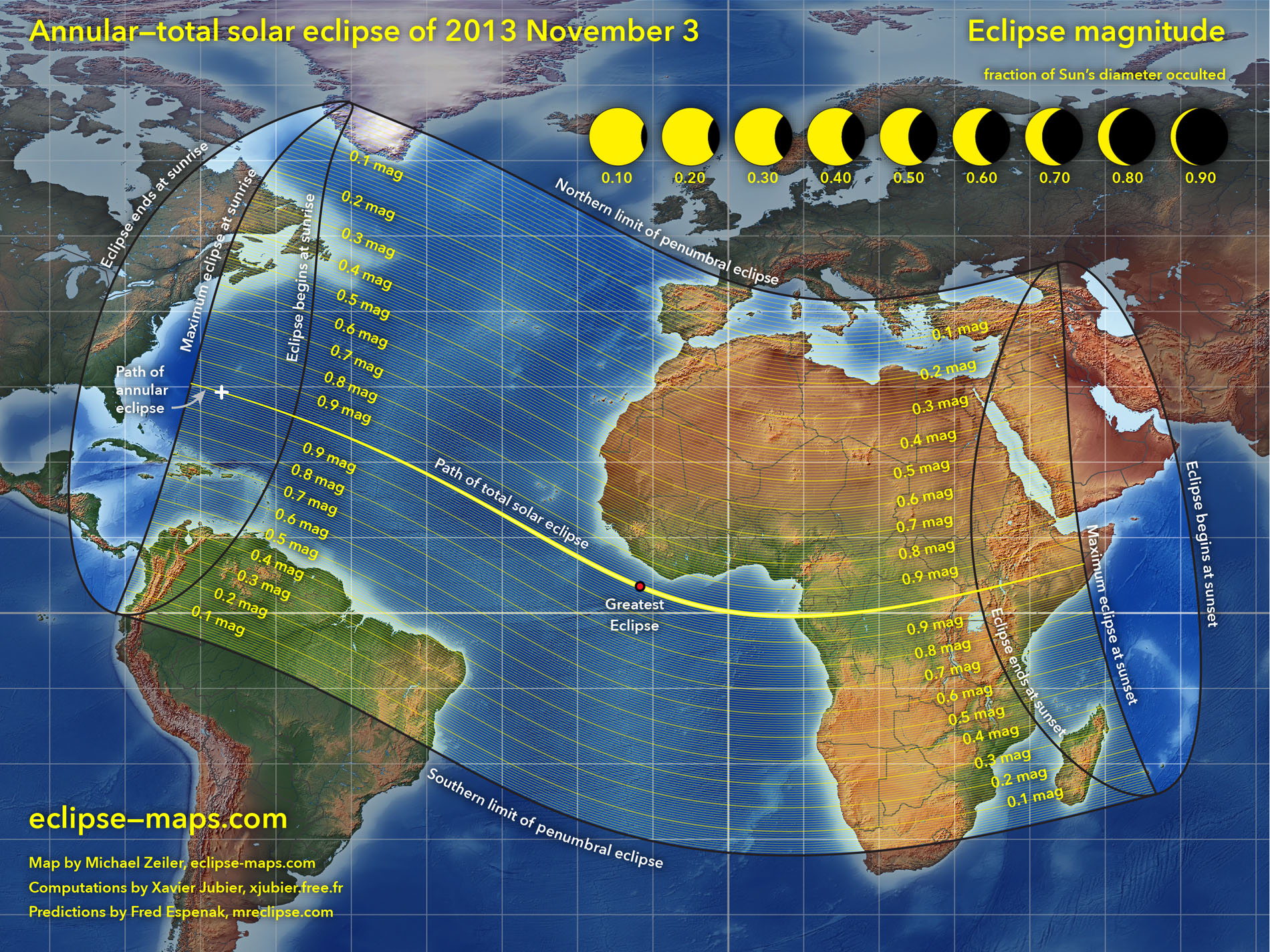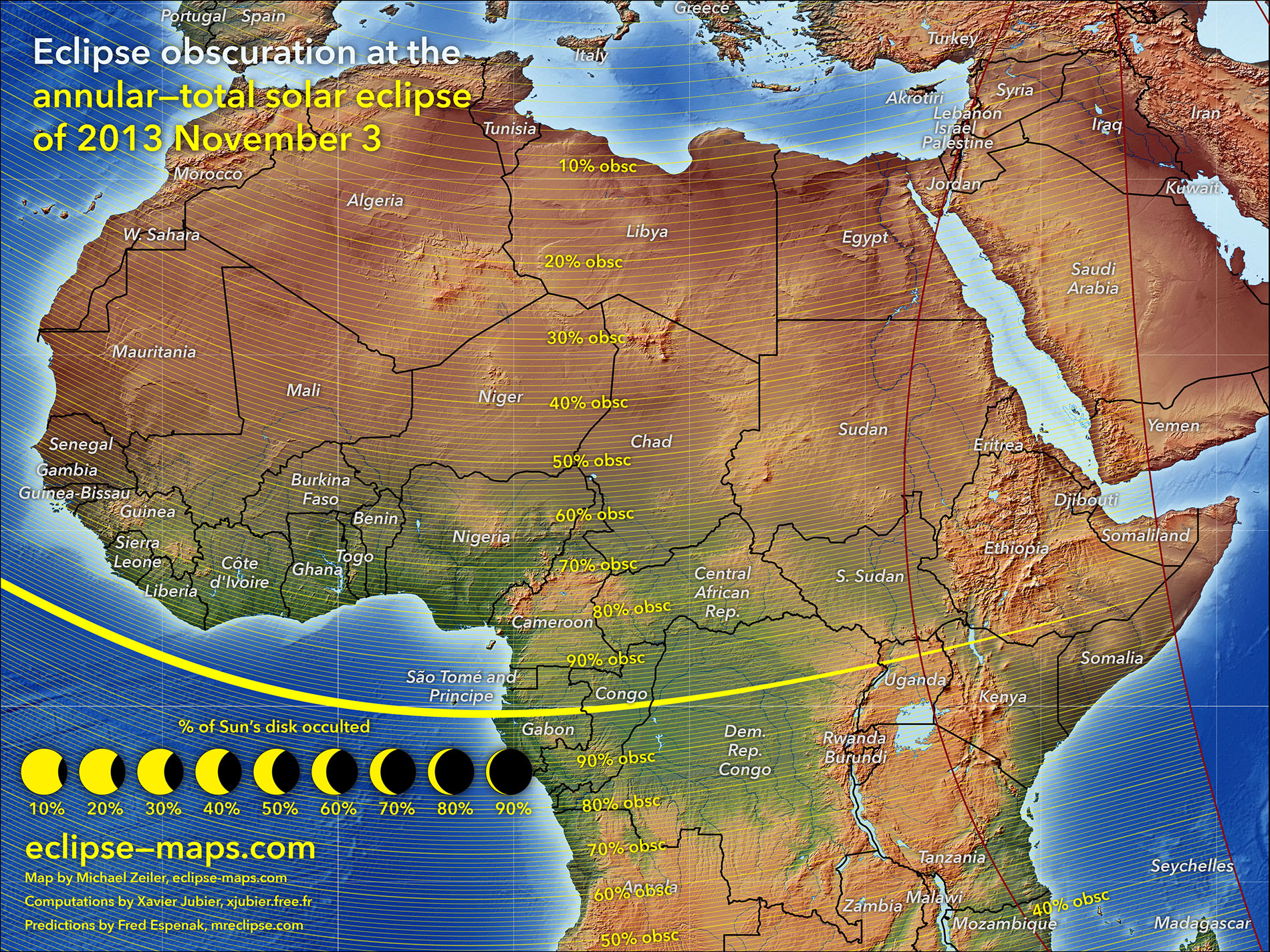'Dramatic' Partial Solar Eclipse Could Wow US East Coast Sunday

Editor's Note: For the latest info and skywatching guides for the Nov. 3 solar eclipse, read: Secrets of Sunday's Rare Solar Eclipse Explained
An amazing partial solar eclipse will be visible across much of Eastern Seaboard as the sun rises on Sunday (Nov. 3), but only if Mother Nature allows, skywatching experts say.
The celestial event is known as a hybrid solar eclipse, a rare event in which the moon blocks most of the sun for some regions on Earth, but covers the star entirely from others. Along the east coast of North America, only a partial solar eclipse will be visible, weather permitting.
"It'll be a weird and dramatic spectacle, if your east horizon is clear," Robert Naeye, editor in chief of Sky & Telescope magazine, said in a statement. [Photos: Nov. 3 Hybrid Solar Eclipse Visibility Maps & Images]
Solar eclipses occur when the new moon lines up directly between the sun and Earth, appearing to cover the disk of the sun as seen from the planet's surface. Because the moon's orbit is tilted, it does not always line up perfectly, which is why there is not a total solar eclipse every month. Partial alignments allow for partial solar eclipses, and when the moon is too close to Earth to block the entire sun it creates a "ring of fire" eclipse, or annular eclipse.
Sunday's solar eclipse will begin as annular eclipse and transition to a total eclipse for observers in Africa. The sun will appear totally obscured for viewers along the path of totality in parts of equatorial Africa. A partial phase of the eclipse, meanwhile, will be visible across most of Africa, the Middle East, southernmost Europe, northern South America and the Caribbean. Observers on the East Coast will be treated to an amazing photographic and skywatching opportunity, provided they have proper solar filters and eclipse glasses for safe viewing.
Cartographer Michael Zeiler of Eclipse-Maps.com has created a series of amazing maps chronicling the entire timeline of Sunday's solar eclipse. You can see those maps at his Nov. 3 eclipse website here.
Breaking space news, the latest updates on rocket launches, skywatching events and more!
Experts at Sky & Telescope magazine say early risers looking for the partial solar eclipse in the eastern United States and Canada should get to a place as far east as possible with an open view of the eastern horizon. There, they should be able to see the sun rise — at about 6:30 a.m. local time — while partially blocked by the silhouette of the new moon.
Editor's note: If you snap an amazing photo of Sunday's solar eclipse or any other celestial sight that you'd like to share for a possible story or image gallery, please contact managing editor Tariq Malik at spacephotos@space.com.
From Boston and New York, the sun will seem to be more than 50 percent covered by the moon, while from Miami and Washington, D.C., our nearest star will appear 47 percent obscured.
The partial solar eclipse will only be visible for about 45 minutes in most places, fading as the sun climbs higher into the morning sky.
"I'll be out bright and early," Alan MacRobert, a senior editor of Sky & Telescope in Cambridge, Mass., said in a statement. "I've got a hillside scouted out with a good view of where the sun comes up."
People as far west as southern Ontario, Ohio, Kentucky, Tennessee, Alabama, and the Florida Panhandle might be able to see the partial eclipse if they have a clear view of the flat eastern horizon, but the sun will only seem briefly to have a small nick taken out of it, Sky & Telescope experts said.
Warning: Never look directly at the sun, either with the naked eye or through telescopes or binoculars without the proper filters. Doing so could result in permanent and serious eye damage, including blindness. Astronomers and amateur eclipse chasers use special filters to safely observe the sun and photograph eclipses.
Sunday's solar eclipse comes on the heels of a partial lunar eclipse on Oct. 18, in which the full moon passed through the outer edges of Earth's shadow (known as the penumbra) in what scientists call a penumbral lunar eclipse.
Follow Megan Gannon on Twitter and Google+. Follow us @SPACEdotcom, Facebook or Google+. Originally published on SPACE.com.

Megan has been writing for Live Science and Space.com since 2012. Her interests range from archaeology to space exploration, and she has a bachelor's degree in English and art history from New York University. Megan spent two years as a reporter on the national desk at NewsCore. She has watched dinosaur auctions, witnessed rocket launches, licked ancient pottery sherds in Cyprus and flown in zero gravity on a Zero Gravity Corp. to follow students sparking weightless fires for science. Follow her on Twitter for her latest project.



